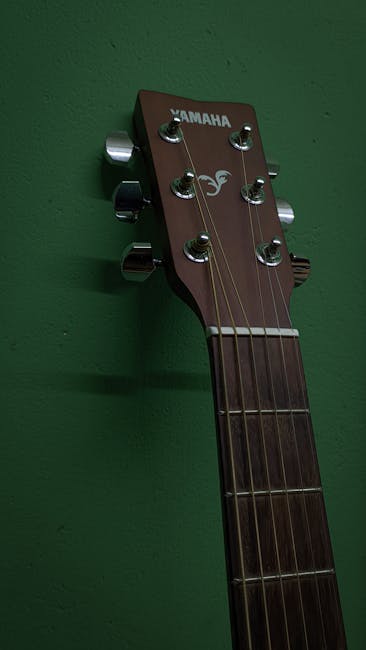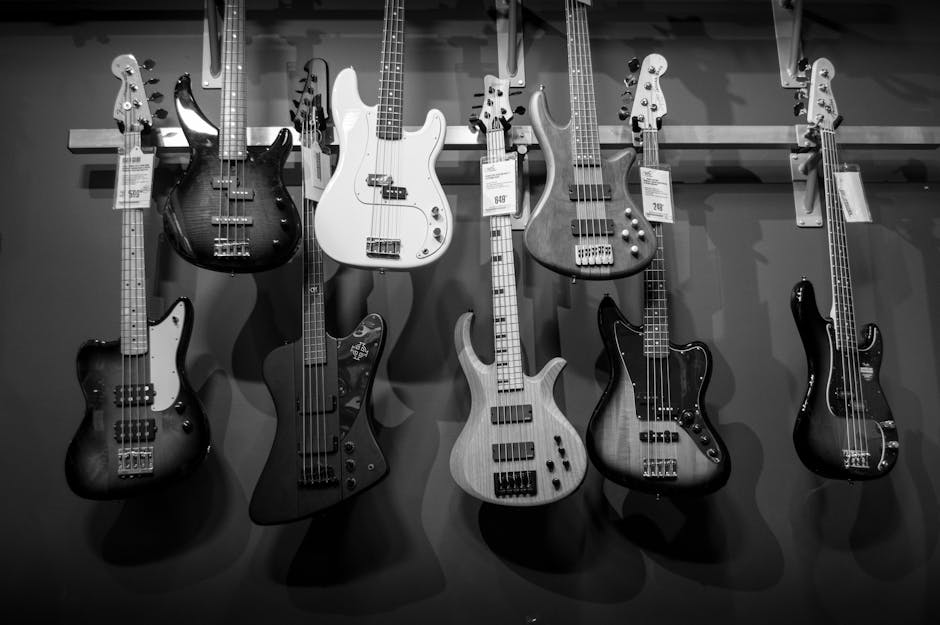So you’ve decided to take the plunge into the world of guitar playing, huh? Well, hold onto your picks and strap in, because selecting your debut six-string can be more overwhelming than trying to tune a ukulele with a banana. But fear not, dear reader, for we’ve compiled a list of expert tips to help guide you through the treacherous waters of choosing your very first axe. So grab your air guitar and get ready to rock (for real this time)!
Contents
- 1 Understanding Guitar Types: Acoustic vs. Electric
- 2
- 3 Deciphering the Impact of Wood and Materials on Tone
- 4 Wood and materials
- 5 Assessing Neck Profiles and Fretboard Radius for Playability
- 6 Exploring Pickup Varieties and Their Influence on Sound
- 7
- 8 Navigating Brands and Price Points: Finding Value in Your Investment
- 9 FAQs
- 10 Strum on, New Rockstar!
Understanding Guitar Types: Acoustic vs. Electric
So you’ve decided to pick up the guitar, huh? Good for you! Now, let’s talk about the two main types of guitars out there: acoustic and electric. They may look similar at first glance, but trust me, they’re as different as night and day.
First up, we have the acoustic guitar. This bad boy is all about that natural, unplugged sound. It’s like the organic, gluten-free, non-GMO version of guitars. No fancy gadgets or gizmos here, just pure, raw goodness. Plus, with an acoustic guitar, you can take your music anywhere – from the campfire to the beach to your grandma’s living room.
On the other hand, we have the electric guitar. Picture this: you plug it in, crank up the volume, and suddenly you’re a rock god. With all those knobs and switches, an electric guitar is like a spaceship compared to the acoustic’s horse and buggy. And don’t even get me started on all the cool effects you can add to your sound – distortion, wah-wah, delay, the list goes on and on.
So, which one should you choose? That’s entirely up to you, my friend. Do you want to strum sweet melodies by the fireside, or do you dream of shredding epic solos on stage? Whichever path you choose, just remember – the guitar is your ticket to musical greatness. Rock on!

size-and-shape“>Evaluating the Importance of Guitar Size and Shape
When it comes to choosing a guitar, size and shape are more important than you might think. Sure, you could just grab the first guitar you see and start strumming away, but why not take the time to consider how the size and shape of the guitar will affect your playing experience?
First off, let’s talk about size. A smaller guitar might be more comfortable for someone with smaller hands, while a larger guitar might be better suited for someone with big, beefy hands. Plus, a bigger guitar means more room for stickers, so you can really show off your personality. And let’s not forget about the portability factor – a smaller guitar is much easier to lug around town than a huge, unwieldy one.
Now, onto shape. There’s no denying that some guitar shapes just look cooler than others. Whether you’re into the classic dreadnought shape or something a little more unconventional, like a Flying V, finding a guitar that speaks to you aesthetically is important. Plus, different shapes can affect the tone of the guitar, so make sure you choose one that fits your musical style.
So, next time you’re in the market for a new guitar, don’t just settle for any old instrument. Take the time to evaluate the importance of size and shape, and find a guitar that truly speaks to you. After all, the right guitar can make all the difference in the world!

Deciphering the Impact of Wood and Materials on Tone
Wood and materials
When it comes to tone, wood and materials can play a huge role in shaping the sound of an instrument. Imagine a guitar made out of rubber – it would probably sound pretty dull and thuddy. Or a violin made out of glass – it would be the most fragile and delicate instrument in the world. And let’s not even get started on a drum set made out of spaghetti noodles – that would be a total disaster!
But in all seriousness, the type of wood and materials used in an instrument can have a significant impact on its tone. Different types of wood resonate in different ways, creating a unique sound for each instrument. For example, a guitar made from mahogany might have a warm, rich tone, while a guitar made from maple might have a brighter, more crisp sound. And let’s not forget about the impact of materials like metal, plastic, and even carbon fiber – they all bring something unique to the table.
So next time you pick up an instrument, take a moment to think about the wood and materials that went into its construction. They may seem like simple components, but they have the power to make or break the tone of an instrument. And who knows, maybe one day we’ll see a drum set made entirely out of spaghetti noodles – it could be the next big trend in the music world!

Assessing Neck Profiles and Fretboard Radius for Playability
Now that we’ve covered the basics of neck profiles and fretboard radius, it’s time to dig deeper into how these factors affect playability. One key consideration is how the shape of the neck profile can impact your comfort level while playing. From thick and chunky to slim and fast, there’s a neck profile out there for every player – it’s just a matter of finding the right fit for you.
When it comes to fretboard radius, the curvature of the fingerboard can have a significant impact on your playing experience. A flatter radius can make it easier to bend notes and play fast lead lines, while a more rounded radius may be better suited for chord playing and rhythm work. Finding the perfect balance between the two can make a world of difference in your overall feel and technique.
Experimenting with different neck profiles and fretboard radii is all part of the fun of being a guitarist. Don’t be afraid to step outside your comfort zone and try something new – you never know, you might just stumble upon your perfect match. Remember, the key to great playability is finding a setup that feels right for you, so keep exploring and dialing in your ideal combination of neck profile and fretboard radius.

Exploring Pickup Varieties and Their Influence on Sound
When it comes to guitars, the pickups play a huge role in the overall sound. Let’s take a closer look at some of the different pickup varieties out there and how they can influence your sound:
- Single-Coil Pickups: These pickups are known for their bright and twangy sound. They are great for clean tones and are often used in genres like country and surf rock. Just be prepared to deal with some pesky hum!
- Humbucker Pickups: These pickups are known for their fat and creamy sound. They are great for high-gain tones and are often used in genres like hard rock and metal. Plus, they have the added bonus of cancelling out that pesky hum!
- P-90 Pickups: These pickups are a bit of a middle ground between single-coils and humbuckers. They offer a warm and gritty sound that works well in a variety of genres. Just be prepared for some extra noise!
Ultimately, the pickup variety you choose will greatly impact the sound of your guitar. So, whether you’re going for that twangy country vibe or that fat rock sound, make sure to choose your pickups wisely!
action-and-setup-for-beginners”>The Significance of Action and Setup for Beginners
So, you’ve decided to dip your toes into the world of action and setup in your writing. Congratulations! You’re about to embark on a journey that will take your storytelling to new heights. But before you jump in headfirst, it’s important to understand the significance of these two key elements.
First up, let’s talk about action. Action is what drives your story forward and keeps your readers engaged. Without it, your story would be about as exciting as watching paint dry. So, spice things up with some epic sword fights, daring escapes, or heart-pounding chases. Remember, the more action, the better!
Next, let’s chat about setup. Setup is like the foundation of your story – it lays the groundwork for everything that comes after. Without a solid setup, your story risks falling flat. So, take the time to introduce your characters, set the scene, and establish the stakes. Your readers will thank you for it!
In conclusion, mastering action and setup is crucial for any aspiring writer. So, don’t be afraid to experiment, take risks, and have fun with it. Your writing will only improve with practice, time, and a healthy dose of action-packed setups. Now, go forth and conquer the literary world!
When it comes to investing in brands, it can feel like navigating a maze with price points as the hurdles. But fear not, dear investor, for there is value to be found amidst the chaos!
First things first, do your research. Look beyond the flashy logos and catchy slogans to find brands that truly hold value. Consider factors like brand reputation, customer loyalty, and market presence. Remember, just because a brand is expensive doesn’t necessarily mean it’s the best investment.
Next, explore the wonderful world of price points. Don’t be afraid to shop around and compare prices. Sometimes the best value can be found in unexpected places. Whether it’s a high-end luxury brand or a hidden gem in the bargain bin, keep your eyes peeled for those hidden treasures!
Ultimately, finding value in your investment is all about striking the right balance between brand recognition and price point. Remember, a wise investor knows that the true value lies in the quality, not just the label. So go forth, brave investor, and may your journey be filled with profitable discoveries!
FAQs
What should I consider when choosing my debut guitar?
First and foremost, you should consider your budget. You don’t want to break the bank on your first guitar, only to find out you actually hate playing it. Next, think about the type of music you want to play. Different guitars are better suited for different genres, so make sure you pick one that aligns with your musical tastes. Lastly, don’t forget about the aesthetics! You want a guitar that inspires you to pick it up and play, so choose one that looks good to you.
Should I go for an acoustic or electric guitar as my first instrument?
If you dream of shredding like a rockstar, then an electric guitar might be the way to go. However, if you prefer the folksy sound of an acoustic guitar, then go for that instead. There’s no right or wrong answer here – it all comes down to personal preference. Why not get both and cover all your bases?
What size guitar should I get?
This may come as a surprise, but guitar sizes actually matter! If you’re on the smaller side, you might want to consider a 3/4 size guitar for easier handling. Conversely, if you’re a big, burly dude, you’ll probably prefer the fuller sound and larger size of a dreadnought guitar. Don’t worry, there’s a guitar out there for everyone – even if you’re a Sasquatch.
Should I buy new or used?
If you’re a baller on a budget, consider buying a used guitar. You can often find great deals on gently used instruments that sound just as good as new. Plus, you’ll get that “vintage” vibe, which is perfect if you’re going for that hipster musician aesthetic. Just make sure you give it a good once-over before handing over your hard-earned cash – you don’t want to end up with a lemon!
Strum on, New Rockstar!
Congratulations! You’re one step closer to becoming the guitar hero you were always meant to be. Remember, choosing the right guitar is just the beginning of your musical journey. So go forth, shred those strings, and rock on! Who knows, maybe one day you’ll be headlining your own stadium tour. And when you do, don’t forget to thank us for these expert tips. Keep rocking, new rockstar!



